NAS Cannon Course
When you don't have provenance for a wreck site they can be murder to date
and with older sites, where timber construction has decayed away and the tides
have swept the smaller items out into an extended debris field leaving only
the bulk metal and the ballast, you can be in trouble. However one item that
stays where you leave it unless somebody comes and takes it away is a cannon.
Cannons from the 1400s to the early 1800s were a necessary self defence on
international merchantmen of this era and the stock in trade of the navies.
Admittedly they were considered valuable and attempts would be made to salvage
them but where a wreck occurred in relatively deep water and was only attested
to by flotsam washing ashore on the local coast the wreck may be undiscovered
or, at least only be salvaged by grappling. Some cannon have dates cast or
engraved in them, some have records from owners or manufacturers and, at worst
they can be dated by style giving and earliest possible date and a probable
date range.
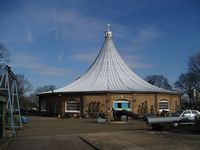
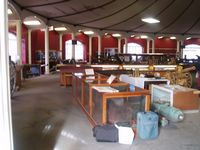
With this resource in mind the NAS organised Ruth Rhynas Brown and Robert
Douglas Smith, a husband and wife specialist cannon team to present a two day
course on measuring, recording and identifying cannons (1400-1820). Since this
was held at the Rotunda at Woolwich, housing the reserve collection of the
museum of the Royal Artillery, we also had the advantage of, not only of an
enormous supply of cannons, but also of Matthew Buck, the curator of the
collection.
The amount of material we had to get through was truly gargantuan and the first
objective was to understand cannons enough to be able to identify the key
features and the significant types both by size, material and design but also
by country of origin. We learnt our names from the Cascable to the Muzzle
taking in Dolphins and Trunions on the way and then it was out into the yard
for a scramble over lines of cannons to see examples of the rules and enough
exceptions to keep us guessing.
Now there are very few NAS courses that don't involve measuring something so we
were soon outside with a cannon, a note pad, a camera and the inevitable tape
measure. We photographed, measured, sketched and carefully transcribed the
inscriptions. Then we used our simplistic knowledge to try to interpret it.
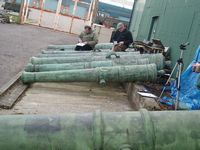
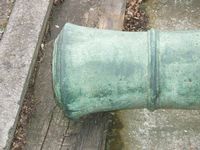
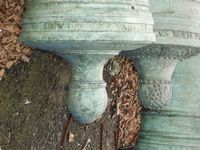
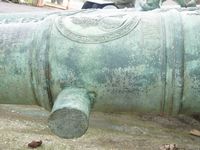
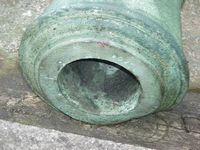

One highlight of the first day was Matthew walking us round his extensive
collection of oriental ordinance including some beautiful presentation pieces
and again some strange items without documentation on how they were used.
The second day moved on from wrought iron and bronze cannon to the cast iron
construction which dropped the price of artillery and made it more commonplace.
Here we concentrated first on the British standard models, their shapes and
markings and then extending this to the European variants. By this time we were
getting more adapted to reading the identifying mouldings and engravings even
after several hundred years of decay and the types were beginning to stick so
we could do the easy ones.
Ruth and Bob were using their extensive knowledge to replan the course as they
became aware of our interests and added an extra section on the ancillary
equipment that would be found with wrecked cannon or that would be left behind
even if the cannons themselves were salvaged. Also they had some details on the
construction methods used and a DVD video of a Danish Experimental project to
make a small wrought iron cannon using blacksmithing equipment.
We finished with a section on doing documentary research. Ruth had copies of
various bills, reports, ledger entries referring to cannon going right back to
the original spy's report of the sailing of the 'Amardo' from 'Lisborne' on the
30th of May 1588. These illustrated the problems of reading 16th century
handwriting but also the nuggets of data that can be discovered as a cannon in
the Rotunda collection, just behind where we were sitting, was detailed in a
contemporary survey of in service naval ordinance.
It would be nice to think that I will shortly happen upon an unknown wreck of
the right period, poke about, find a cannon and pronounce a definitive
identification on surfacing but that is hardly likely. At least I know what to
look for, what to measure, where to poke and where to point the camera so we
can make a sensible report. The personal smugness of walking past a sea side
display and remarking casually "Oh it's a Bloomfield. English. George the
third." I will keep to myself.
Written by Nigel Hewitt and published in the News letter of the
Nautical Archaeological Society 2005.2
The pictures can be accessed by clicking the thumbnail but they tend to be 900K+ files
Pictures by Nigel Hewitt
Thumbnails by Easy Thumbnails

 by Nigel Hewitt
by Nigel Hewitt

 by Nigel Hewitt
by Nigel Hewitt